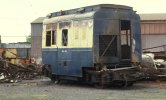AHBD
Member
Given that overall BR came to the conclusion that diesel-electric was the way to go (as opposed to diesel-transmission) for locomotives*, why were most past underfloor engined DMUs designed as DMUs rather than DEMUs? I had thought electric generators would have scaled down Ok?
*excluding the Hydraulics which didnt exactly disprove them.
*excluding the Hydraulics which didnt exactly disprove them.


